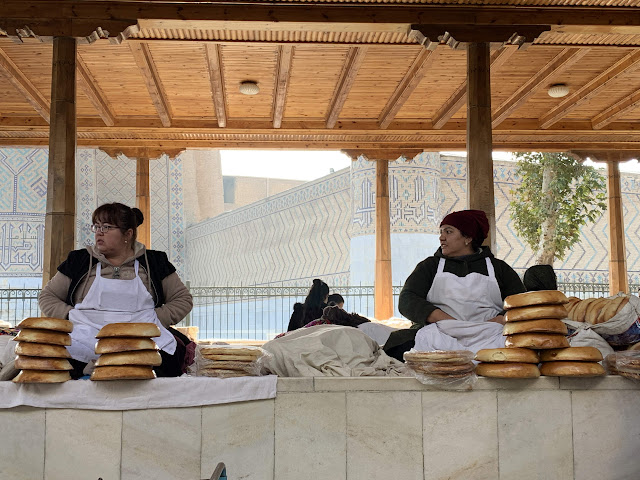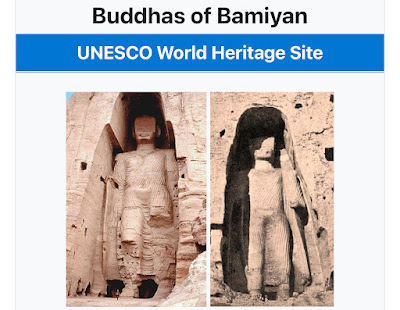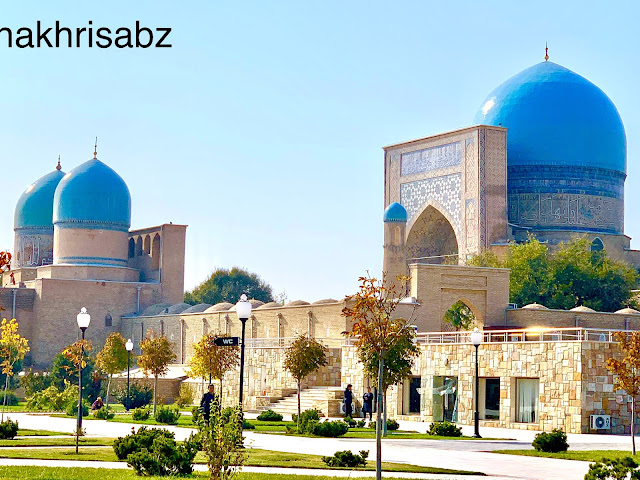My Golden Travels in Uzbekistan Along The Bygone Silk Road, Blog 46, nguptatravelscrapbook.blogspot.com 17/7/2024
My Golden Travels in Uzbekistan along the Bygone Silk Road. Blog 46 17/07/2024
nguptatravelscrapbook.blogspot.com
Some famous quotes on The Silk Road
Myself and my husband along with Dr Vinod and Jyoti Chandhok
The Silk Road, a phrase that resonates with the grandeur of history and the magnificence of cultural exchange, was a gateway to a world of intrigues and wonders. It invokes images of majestic processions of camels and caravans loaded with exotic goods, travellers adorned in vibrant attire, bustling markets, and ancient palaces with intricate adornments. Traders converged at large markets where different cultures met, and today, these have evolved into the cosmopolitan cities of the modern-day Silk Road in Central Asia. Laden with exotic goods and silk fabric, traversing mainland Asia's vast deserts, mountain passes, fertile valleys, and steppes, the Silk Road is a tale of grandeur waiting to be explored.
In its glorious heydays, the trade routes were not referred to as Silk Road trips or the commerce as Silk Road trade. The term Silk Road was coined late in 1877 by a German traveller named Ferdinand Richthofen during his expeditions to the East.
Bihumped camels in Uzbekistan, a great tourist attraction for pictures
Why did I decide to travel to Uzbekistan?
A characteristic blue-domed mosque
The allure of the Silk Road is timeless. Travelling its paths is as exotic, adventurous, and diverse as it was millennia ago. Its history and cultural significance continue to captivate and intrigue us.
Uzbekistan, located at the heart of the Eurasian continent, played a crucial role in the transcontinental system of the Silk Roads. Its diverse landscapes formed a crossroads along the route, leaving a rich historical legacy still visible today. Accompanied by our dear friends, Dr Vinod and Jyoti Chandhok and my husband, Dr Vinod Gupta, I eagerly embarked on an escorted trip to Uzbekistan in November 2019, just before the onset of COVID-19.!The anticipation of exploring the Silk Road in this ancient land was palpable.
I read books about the Silk Road before my departure for Uzbekistan to follow its ancient traces.
- The Silk Roads by Peter Frankopan v trendy
- The New Silk Roads By Peter Frankopan
- Shadow Of The Silk Road by Colin Thubron
- Samarkand, Bukhara, Khiva by Flammarion
- From The Holy Mountain By William Dalrymple
Having read various portrayals of the Silk Road in my spare time, Uzbekistan remained my choice to travel to experience some of the remaining versions of the old Silk Road trails. Moreover, the cities and regions of Uzbekistan, including Samarkand with its stunning Registan Square, Bukhara with its ancient Ark fortress, Khiva with its well-preserved old town, Ferghana Valley with its lush landscapes, and Tashkent with its modern cityscape, consistently expressed an exotic and faraway land to me. These cities are now easily travelled to through escorted and planned itineraries arranged by travel agents, providing first-class hotels and travel options via flights, fast trains and highway coach routes.
A collection of hand prints about the Silk Road
In my subsequent follow-up blog, I will describe my journey within Uzbekistan, restricting this narrative to the charms, myths, legends, and fables of the Silk Road alone.
A BRIEF HISTORY OF THE SILK ROAD
As early as 1000 BC, some records confirm that silk was found amongst the burial goods of Egypt's mummies, suggesting that the Silk Road traders were already active by then.
Suzanni, Silk crafts, are popular in Central Asia.
However, it's generally held that establishing stable trading patterns and diplomatic links can be attributed to Zhang Qian, a Chinese philosopher, in the 2nd Century B.C. He travelled far beyond China's borders, returning with reports and possibilities. One of his most significant finds was the discovery of tall, solid and heavenly horses from the Ferghana Valley since horses were a status symbol for the Chinese Royal Court. Fortunately, Chinese silk was just as craved by Central Asia's rulers, so the trade was possible and greatly encouraged on both sides. The wealthy Romans, too, were fascinated by silk, interweaving the silk fabric in their dresses. Hence, the importance of the Silk Road was further developed.
Various silk roads
WHY WAS THE SILK ROAD IMPORTANT?
The Silk Road, an ancient and mainly pedestrianised trade route, linked China with the West, carrying goods, beliefs, and contentions between the great Romans, Chinese, and other civilisations on the way. Silk travelled westwards, and wool, gold, and silver travelled eastwards. The diversity of goods and beliefs that traversed the Silk Road offered travellers a variety of experiences.
Apart from goods trade, the Silk Road had another crucial role – boosting communication between cultures and multitudes. As the route was established, thoughts and ideals of Zoroastrianism, Buddhism, Judaism, Christianity, and Islam further. Revolutionising ideas of mathematics, algorithms, paper making, book printing and even gunpowder travelled the Silk Road. However, the Silk Road also had destructive powers – conflicting civilisations would engage in wars over trade advances and territories. Diseases, too, spread along the routes that brought silk and spice, namely the Bubonic plague, to Europe in the 14th Century.
What was the physical state of the Silk Road?
Map of ancient Silk Road
With no one government to provide maintenance, the roads were in poor condition, often just dirt roads. Bandits and looters were common. Traders joined in caravans with camels or other pack animals like asses, mules and yaks to protect themselves. Over time, large caravanserais or inns were built to board the travellers along these routes. Few traders travelled the entire route, yielding many go-betweens and trading posts.
What was the spirit along the Silk Road?
Eye-catching Blue Dome
The Silk Road journey was a testament to the travellers' resilience, endurance, and goodwill. It was a journey through Asia, a glorious narrative of an ancient world. A wealth of goods traversed the Silk Road. Merchants carried silk from China to Europe, where it adorned royalty and wealthy patrons. Other Asian commodities included jade, precious and semi-precious stones, porcelain, tea, and spices. In exchange, gallant horses, glassware, textiles, and manufactured goods journeyed eastward. One of the most renowned Silk Road travellers was Marco Polo, who embarked on his journey to China (then Cathay) at 17. Another well-known Silk Road traveller was Ibn Battuta (14th Century), known for his famous travel quote, "Traveling – it leaves you speechless then turns you into a storyteller."
The Silk Road, a melting pot of cultures, religions, and ideas, shaped global history. Towns along the route evolved into multicultural cities, fostering the exchange of information that led to the advent of new technologies and innovations. The introduction of horses to China bolstered the might of the Mongol Empire, while the spread of gunpowder from China revolutionised the nature of warfare in Europe and beyond. The Silk Road's influence was far-reaching, shaping history's course in ways still felt today.
What is the difference between the Silk Road and the Silk Route?
In my blog here, I have used the terms Silk Road and Silk Route interchangeably.
The term' Silk Road' is commonly used to denote the trade network of routes, but some historians prefer' Silk Routes '. The latter better captures the multitude of trails taken by merchants and traders, each contributing to the rich tapestry of cultural exchange.
Where did the Silk Road start, and where did it end?
The Silk Road started in north-central China in the Xi'an province, which my husband and I visited in 2006. A dirt road track lengthened west along the Great Wall of China, across the Pamirs mountains in Afghanistan and central Asia, and into the Levant and Anatolia. We visited the latter in 2023, where the remains of Ephesus reminded us of the unexpected tales of the Silk Road.
How long was the Silk Road?
The Silk Road, an ancient trade route that linked the Western world with the Middle East and Asia, was about 4,000 miles (more than 6,400 km).
The silk route remained the primary trade conduit between China and the Roman Empire and later between medieval European kingdoms and China.
What has happened to the Silk Road in recent times?
Trades, exchanges of goods, and travel along the Silk Road peaked from 200 to 900 CE. Several reasons contributed to the Silk Road's downfall, including the use of sea trade routes that allowed merchandise and traders to travel long distances faster and the fall of the Tang dynasty in China. The disappearing communities of Sogdian merchants, the primary merchants for much of the long-distance Silk Road trade, also led to much less use of the Silk Road.
Who were the Sogdians?
Sogdia, or Sogdiana, was an ancient Iranian civilisation in present-day Uzbekistan, Turkmenistan, Tajikistan, Kazakhstan, and Kyrgyzstan. However, in the 13th and 14th centuries, exchanges across Asia revived during the Mongol period, when Mongols ruled most of Asia. Mongols followed the old Silk Roads overland on the best horses brought in from the West earlier on to China.
Further discussion on the Silk Road
Connecting the eastern and western margins of the Eurasian continent, routes of the Silk Road crossed China, India, Pakistan, Afghanistan, Kazakhstan, Kyrgyzstan, Tajikistan, Turkmenistan and Uzbekistan. In the East, the road reached the Korean peninsula and Japan; on the West, it reached Russia, Eastern and Western Europe; in the south, it reached India and the Middle East; and in the southwest, to Antalya, Turkey. The Silk Road was a transit road with a two-way movement of goods, prevailing scientific ideas and achievements. The Silk Road also transmitted and spread cultural and religious values. During specific historical periods, the Silk Road was used as an essential and quick means of disseminating information to merchants, travellers, and envoys.
Daily bazaar scene in Uzbekistan
Many historians consider that the Silk Road first served as a route for exporting Chinese silk to Western countries, including Rome. However, many archaeological findings show that goods produced in Rome, Byzantium, India, Iran, the Arab Caliphate, and later, Russia and other European countries were imported to China. A long list of exchanged and exotic goods comprised frankincense and jasmine perfumes, cardamom, nutmeg, ginseng and bile of a python, gold and silver, expensive furs and coins, bows, arrows, swords and spears, carpets and textiles, diamonds, jade, amber, corals, ivory, dyes and minerals, and much more. Privileged and approvingly pedigreed species of Fergana horses, Arab and Nisean horses, camels and elephants, rhinoceros and lions, cheetahs and gazelles, hawks and falcons, peacocks, parrots and ostriches passed the routes of Silk Road to fetch higher prices. Cultivated crops, such as grapes, apricots, melons, vegetables, and sugar, enriched their geographic distribution with the help of merchants.
Music scenes in Uzbekistan
Aside from the movement of goods and animal trade, the Silk Road served as a channel for disseminating fashion and artistic styles that became widespread once grounded in a new ethnic-cultural environment.
The travelling of Buddhism along the Silk Road.
Buddhism was one of the most far-reaching religions carried along the Silk Roads, originating in India and spreading to the East and West via the trade network.
More evident were the cave temples crafted by Buddhist monks travelling along the Silk Road. These cave temples were often located around significant stops along the Silk Road, such as Bamiyan, in present-day Afghanistan. These colossal figures presided over the Bamiyan Valley for over 1000 years. Tragically, the two monumental Buddhas of Bamiyan were destroyed by the Taliban in 2001.
Import of architectural style, bricks and tiles along the Silk Road
Timurid tile styling
There is a theory that the Silk Road contributed to popularising the Timurid style of ceramics, which is distinctive for its blue palette of paint on a white background. First emerging in workshops of Chinese emperors during the Yuan dynasty (CE 1279-1369), the blue pottery style, with a Cobalt base, received its across-the-board dispersal in Iran, Turkey, and Central Asia.
Through the Silk Road, applied arts, architecture, wall paintings, music, dance, and theatric performances of the Middle Ages were transported across the continents. It is widely accepted that the most famous music in Tang China came from cities of Eastern Turkestan and Central Asia, including Kashghar, Bukhara, and Samarkand, merging with Chinese musical traditions.
Is the Silk Road still used today?
With the gradual defeat of the Roman domain in Asia and the rise of power in the Levant, the Silk Road became increasingly unsafe, unpopular, and much less traversed. But once again, in the 13th and 14th centuries, the route was revived by the Mongols; at that time, the Venetian traveller Marco Polo used the Silk Road to travel to China.
Legacy and the Revival of Silk Road
This shift in trade routes had significant implications for global trade and cultural exchange. Yet, the legacy of the Silk Road endures, influencing modern transcontinental connections and serving as a testament to the enduring impact of this ancient trade route.
Since the 1970s, UNESCO has promoted the Silk Road and its civilisations. The network of roads between the XIAN and Tiian Shan corridor is a UNESCO World Heritage Site, covering the ancient Silk Road and historical sites along the route.
I have enlisted various programmes and platforms to engage in the Silk Road projects.
- In 1993, the UNWTO (U.N. World Tourism Organisation) was established to promote responsible and easily accessible tourism and preserve the heritage of the Silk Road.
- UNESCO Silk Road PLatform
- The Silk Road Project
- The New Belt and Road Initiative
- Khorgos: A new Eurasian land bridge is being built across the borders of China and Kazakhstan, along with a new railway track for trade and transportation of goods.
- The Karakoram Highway connects the Gilgit-Baltistan region to the ancient Silk Road and runs about 1300 km from Kashgar, Xinjiang, to Abbottabad, Pakistan.
The Silk Road, a leading trade artery for many countries and people, was also a road of cooperation, mutual interpretations, and the enrichment of different cultures. I am glad to learn that Central Asia has become the new gateway of travel amongst the explorers and alike, including the five Stans, namely Uzbekistan, Kazakhstan, Kyrgyzstan, Tajikistan and Turkmenistan. We had a most exotic and inspiring trip to Uzbekistan, visiting the historic cities of Samarkand, Bukhara, Khiva and Tashkent.
Please put your comments on my Blogspot website as above.
Dr ( Mrs) Nirmal Gupta FRCOG FRCS























Comments
Post a Comment